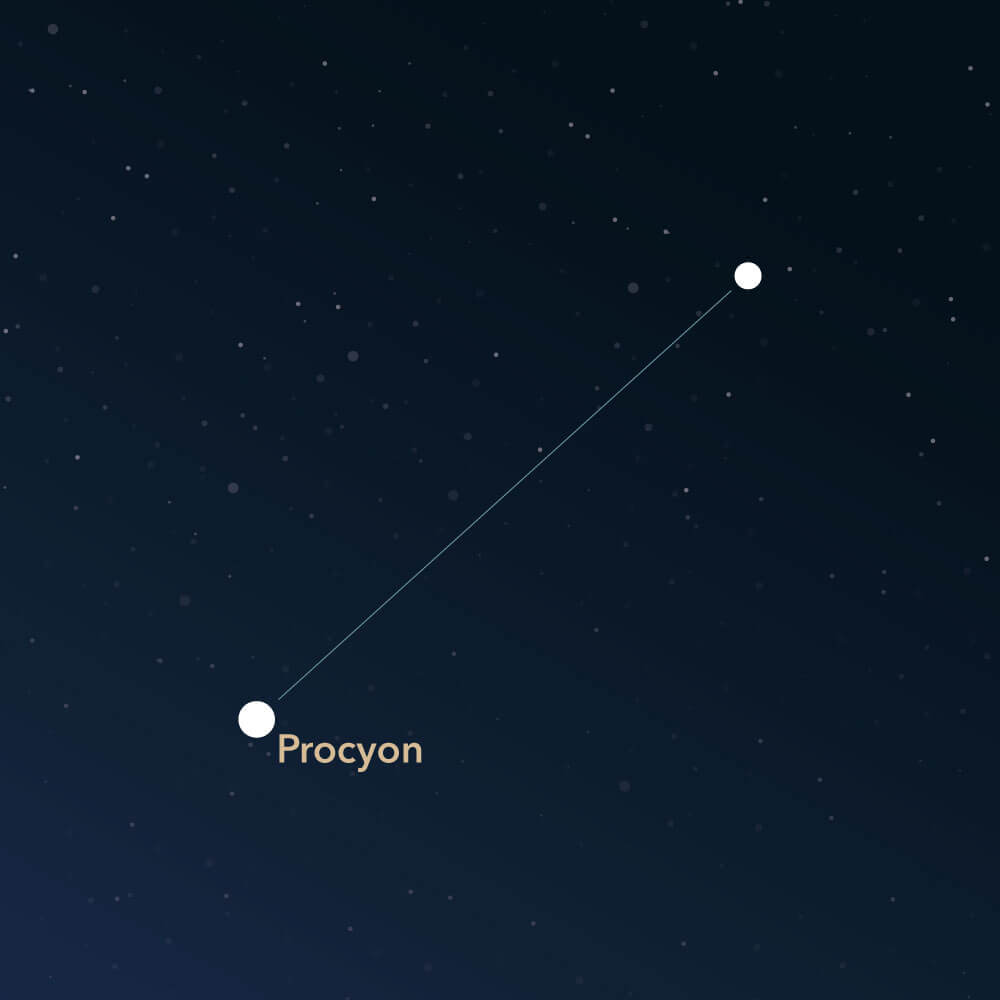The constellation Canis Minor
Caratteristiche
- Nome latino
- Canis Minor
- Emisfero
- Emisfero settentrionale
- Visibilità
- January - March
- Area
- 183 deg²
- Stella più luminosa
- Procyon (HIP number 37279)
- Specialità
- Galaxies, open star clusters

The Canis Minor, commonly named as Lesser Dog or Little Dog, is one of the 48 constellations described by the Greco-Roman astronomer Claudius Ptolemy in ancient times. The best-known version of its origin is based on an exciting and, at the same time, tragic story by a Roman writer. Some interesting deep-sky objects are located in its area, but they are challenging to observe.
Hemisphere, visibility, and area
The Canis Minor constellation is located near the celestial equator and, therefore, visible from almost all regions of the world. Only in Antarctica can it not be seen.
The best time to observe this constellation is from January to March, with mid-February being the most prominent period.
With an area of 183 square degrees, Canis Minor is a relatively small constellation and ranks 71st in size among all the 88 constellations.
The constellation is represented by a straight line connecting its two main stars, which are the only stars brighter than 3 mag in the area of Canis Minor.
The brighter of the two stars is Procyon (Latin: α Canis Minoris, Alpha Canis Minoris), which derives its name from the Greek word meaning "before the dog." The name arose due to the fact that it rises before Sirius, the brightest star in Canis Major (known as Greater Dog). Procyon is a double-star system with an apparent magnitude of roughly 0.37. It lies at about 11.4 light-years from earth, making it one of the nearest stars to our solar system.
The star Procyon is a useful guide for locating Canis Minor in the night sky. But also, the neighboring constellations can help to find it. The Canis Minor is nestled between four other constellations. In addition to Gemini and Cancer, which lie on the ecliptic and are known in particular from astrology, the Monoceros and the Hydra also border on each other.
Specialties in the constellation
In the area of the Canis Minor constellation, there are various galaxies and open star clusters. However, none of these objects can be observed with a small or medium-sized telescope.
One of them is the spiral galaxy with the catalog number NGC 2485. Its distance from the Milky Way is estimated to be around 200 million light-years. It was discovered by the German astronomer Albert Marth in March 1864.
Another type of galaxy in Canis Minor is NGC 2496. It is an elliptical galaxy whose distance from the Milky Way is approximately 421 million light-years. It was found by the American astronomer Lewis Swift in November 1885.
A pair of galaxies is also located in this constellation. They are cataloged with the number NGC 2403. The German-British astronomer William Herschel discovered them in March 1784. Their distance from the Milky Way is estimated to be about 230 million light-years.
Mythology
In Greek mythology, the Canis Minor was associated with a hunting dog of the constellations Orion or Boötes.
However, the better-known version of its mythological origin comes from the Roman writer Hyginus. It involves the loyal dog Maera and its master Icarius.
Icarius was learning to make wine and eagerly offered his first self-made wine to a group of shepherds, who drank it gratefully. Unaware of the effects of the alcohol, they assumed Icarius was trying to poison them and killed him in a fit of rage. Finally, they disposed of his body under a tree.
After Icarius failed to return home, his faithful dog Maera set out to search for him. The dog eventually found the scent of Icarius' corpse. Ensuing, he led Icarius' daughter, the virgin Erigone, to the body.
Overcome with grief, Erigone killed herself by hanging herself from the tree. And also the dog Maera decided to end his life by drowning himself in a nearby well.
As a reminder of this story, the participants were finally placed in the sky as constellations.
PubblicatoLeggi altri articoli interessanti

An overview of all 88 constellations
Learn more about all 88 constellations and read interesting information about the mythology, visibility, and features.

App Planetario
Discover the night sky with our planetarium app!
Available for iOS and Android.

Dai un nome a una stella nella costellazione Lesser Dog, Little Dog
Name a star in a constellation and create something that lasts for eternity.